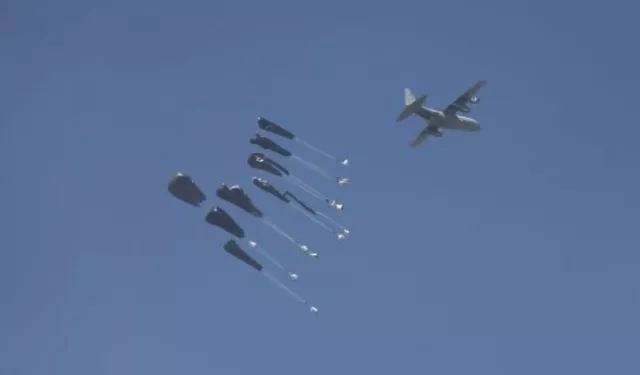At least 73 trucks carrying humanitarian aid entered the besieged Gaza Strip on Sunday, even as Israeli bombardment continued across the territory, defying the military’s declared temporary daily pause for humanitarian purposes.
The trucks delivered flour, sugar and food parcels, facilitated by WFP, while three Jordanian and Emirati aircraft air-dropped approximately 25 tons of aid to northern and southern Gaza.
A journalist based in northern Gaza told Al Manassa that some 30 trucks arrived in the northwestern areas via the Israeli Zikim checkpoint on Sunday evening. Concurrently, aircraft dropped aid supplies over the same region earlier in the afternoon.
They confirmed that all trucks were swiftly taken over by waiting residents, with dozens returning with bags of flour and food parcels. However, Israeli occupation forces opened fire directly at the hungry crowds, injuring more than 100.
Seventeen were killed and transported to Al-Shifa Hospital.
In the south, another 30 trucks brought aid to areas in and around Khan Younis, some via the Morag Corridor in the far south. A journalist on the scene told Al Manassa that the trucks were loaded with food parcels bearing the logo of the Egyptian Red Crescent.
Hungry residents, who had been waiting for the convoy, took control of the aid themselves in a desperate bid to secure food, they added.
The source noted that additional trucks from the WFP entered through central Khan Younis, carrying flour. These, however, were reportedly intercepted by locals before they reached distribution warehouses. Arab aircraft also airdropped aid to the same area around noon.
One truck driver, who requested anonymity, told Al Manassa that Israeli occupation forces kept the aid convoy waiting for hours at the Karm Abu Salem crossing during inspections.
According to him, drivers had been instructed to allow people to take the aid if large crowds blocked the road. Consequently, he and his fellow drivers were compelled to stop only in areas approved by the occupation army.
“People are entering dangerous military zones to wait for the aid, where we’re not allowed to stop — so we’re forced to keep driving, even though it’s extremely difficult to move through the crowds.” He attributed the injuries reported at hospitals to people being run over as they rushed the trucks before they reached areas where the Israeli army permits them to stop.
In central Gaza, fewer than 10 trucks carrying vegetables and limited food items were stopped by residents east of Deir Al-Balah. A witness said most trucks belonged to traders and carried sugar, cooking oil, rice and salt. Only one vehicle carried boxed food parcels.
Meanwhile, Gaza’s Government Media Office said famine is worsening at unprecedented levels, affecting 2.4 million people. It reported 133 starvation-related deaths, including 87 children.
“Over the past two days, media outlets have reported that several countries and organisations intend to send hundreds of trucks to break the famine in Gaza.” the office said in a statement. “But the reality is damning — only 73 trucks entered northern and southern Gaza, most of which were looted and robbed under the watchful eye of the occupation forces, who are clearly intent on preventing the aid from reaching distribution warehouses, as part of a deliberate policy of engineered chaos and starvation.”
The office accused the international community and the US of complicity in Israel’s starvation policy and of spreading misinformation about incoming aid.
It said the only solution is for Israel to fully reopen crossings, end the blockade and allow the unconditioned entry of food and infant formula.
On Sunday, Israeli army spokesperson Avichay Adraee posted a map on X marking designated combat zones in red and coastal areas from northern Gaza to Khan Younis as eligible for the “humanitarian pause” between 10 am and 8 pm.
He also confirmed that despite the humanitarian pause, military operations would continue without interruption in the designated combat zones.
Yet, Israeli airstrikes hit a home west of Gaza City—one of the designated safe areas—during the pause, killing five people, including children, and injuring 17 others.
Israeli tanks also reportedly advanced into Al-Tuffah neighborhood east of Gaza City, targeting homes with artillery shells and drone-fired missiles. Several civilians were killed and others wounded, with emergency crews unable to reach the scene due to ongoing operations.
In Khan Younis, Israeli occupation forces launched three separate strikes. One hit a tent sheltering the Al-Amour family in Al-Mawasi, killing seven and wounding others, according to medical staff at Nasser Medical Complex.
Two other strikes targeted homes in the Japanese neighborhood and the industrial area. One assault destroyed a four-story building housing about 20 members of the Zaarab family; others remain under the rubble. Another strike leveled a three-story house belonging to the Nofal family, from which four bodies were recovered, though about 15 others are missing, a relative told Al Manassa.
The strikes came despite the occupation army’s Sunday announcement of a “tactical suspension of military activities for humanitarian purposes,” coordinated with the UN and aid organizations.
Additionally, secure corridors, operational between 6 am and 11 am, were established to allow aid convoys to travel safely within Gaza and deliver food and medicine.
